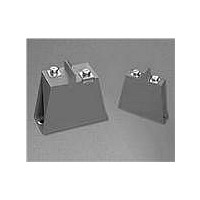V321BA60 Littelfuse Inc, V321BA60 Datasheet - Page 3

V321BA60
Manufacturer Part Number
V321BA60
Description
VARISTOR INDUST 320V 1100J BA
Manufacturer
Littelfuse Inc
Series
BAr
Type
MOVr
Specifications of V321BA60
Varistor Voltage
510V
Current-surge
50kA
Number Of Circuits
1
Maximum Ac Volts
320VAC
Maximum Dc Volts
420VDC
Energy
1100J
Package / Case
Chassis Mount
Voltage Rating Dc
420 V
Voltage Rating Ac
320 V
Clamping Voltage
760 V
Peak Surge Current
50 KA
Surge Energy Rating
1100 J
Capacitance
7500 pF
Operating Temperature Range
- 55 C to + 85 C
Mounting
SMD/SMT
Dimensions
60 mm Dia. x 100 mm L
Termination Style
Screw
Brand/series
BA Series
Current, Peak
50000 A
Energy Rating
1100 Joules
Mounting Style
Bolt-Down
Package
Screw
Resistance, Insulation
1000 Megohms
Technology
Metal Oxide
Temperature, Operating, Maximum
85 °C
Temperature, Operating, Minimum
-55 °C
Terminal Type
Screw
Voltage, Ac
320 VAC
Voltage, Clamping
760 V
Voltage, Dc
420 VDC
Voltage, Operating
320⁄420 VAC/VDC
Voltage, Varistor
539
Lead Free Status / RoHS Status
Contains lead / RoHS non-compliant
Lead Free Status / RoHS Status
Lead free / RoHS Compliant, Contains lead / RoHS non-compliant
©2010 Littelfuse, Inc.
Specifications are subject to change without notice.
Please refer to www.littelfuse.com/series/ba or /bb.html for current information.
Stand by Power Dissipation vs Applied V
Temperatures
Power Dissipation Ratings
Should transients occur in rapid succession, the average power
dissipation required is simply the energy (watt-seconds) per pulse
times the number of pulses per second. The power so developed
must be within the specifications shown on the Device Ratings
and Characteristics Table for the specific device. Furthermore,
the operating values need to be derated at high temperatures as
shown in the above diagram. Because varistors can only dissipate
a relatively small amount of average power they are, therefore, not
suitable for repetitive applications that involve substantial amounts
of average power dissipation.
Figure 1
Figure 3
100
90
80
70
60
50
40
30
20
10
0.08
0.06
0.04
0
-55
1.0
0.8
0.6
0.4
0.2
0.1
50
TYPICAL TEMPERATURE COEFFICIENT
OF POWER DISSIPATION = 2.2%/
MAX
MAX
TYP
80
60
PERCENTAGE OF MAXIMUM RATED V
AT
AT
AT
T
T
T
70
AMBIENT TEMPERATURE (
A
A
A
= 25
= 85
= 25
80
o
o
o
C
C
C
90
90
100
110
o
C
o
100
120
C)
Rms
Varistor Products
Industrial High Energy Terminal Varistors > BA/BB Series
at Varied
130
RMS
(%)
140 150
110
Revision: June 24, 2010
Typical Stability of Standby Power Dissipation at Rated
V
Peak Pulse Current Test Waveform
Figure 2
Figure 4
RMS
vs Time
0
T = Time from 10% to 90% of Peak
T
T
Example - For an 8/20 μs Current Waveform:
1
1
2
0.5
0.4
0.3
0.2
0.1
= Virtual Origin of Wave
= Rise Time = 1.25 x T
= Decay Time
0
O
100
8μs = T
20μs = T
0
90
50
10
1
1,000 HOURS, T
1
2
= Rise Time
= Decay Time
TIME AT RATED V
T
T
1
A
10
T
= 85
2
Figure 26
o
C
RMS
(HOURS)
100
TIME
BA/BB Varistor Series
1,000















